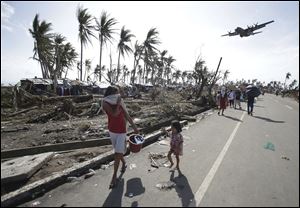
Anger takes hold in city ravaged by typhoon
11/12/2013
Survivors look up at a military C-130 plane as it arrives at typhoon-ravaged Tacloban city, Leyte province in central Philippines on Monday, Nov. 11, 2013. Haiyan slammed the island nation with a storm surge two stories high and some of the highest winds ever measured in a tropical cyclone.
TACLOBAN, Philippines — Wearing face masks or pulling their shirts up over their noses to mask the smell of rotting flesh, a procession of typhoon survivors three miles long walked toward the shattered airport here today to beg for food, water or a flight out of the chaos of what used to be a city of 220,000.
They witnessed the despair of survivors like Erroll de la Cruz, 34, who squatted next to the pavement to scrawl the names of his wife, Michelle, and her 7-year-old son, Matthew, on a piece of plywood. Then he walked across the crowded road and laid the plywood between their corpses, in the hope that their lives would be remembered, and perhaps their bodies someday traced.
“I don’t think I can handle this by myself,” he said quietly.
The people of Tacloban, on Leyte Island in the east-central Philippines, have been struggling largely on their own for almost five days to deal with the devastation of Typhoon Haiyan, as the civilian and military authorities of the Philippines try to cope with a natural disaster of a scope far beyond expectations.
Some residents were understanding of the delays in distributing food. Lamberto Patau, 31, a bus dispatcher, said more relief shipments had arrived than could be handed out. “There is food, but there is no one to distribute it, because they were all victims,” he said.
Some survivors, however, were growing angry.
“There’s no food coming, but that is not as big a problem as dealing with the dead,” said Juanita Experas, 63, who lives in a village near Tacloban. “There are dead bodies everywhere, and it is making us sick.”
The devastation apparent during an 8-mile drive into the city center made the extent of the challenge clear. Mounds of debris up to 15 feet high towered next to the main road. Concrete pillars and other hazards had fallen into the traffic lanes, forcing drivers, motorcyclists and pedestrians to dodge and weave.
Jennifer Cicco, the administrator of the Leyte Island chapter of the Philippines Red Cross, said the conservative estimate from provincial officials was that in addition to the deaths in Tacloban, a city of 220,000, about 10,000 people had died in surrounding Leyte province, home to 1.3 million. The official death toll for the entire country was 1,798 as of today, according to the National Disaster Risk Reduction and Management Council.